Pengpeng Li
Memory-Efficient 2D/3D Shape Assembly of Robot Swarms
Sep 30, 2025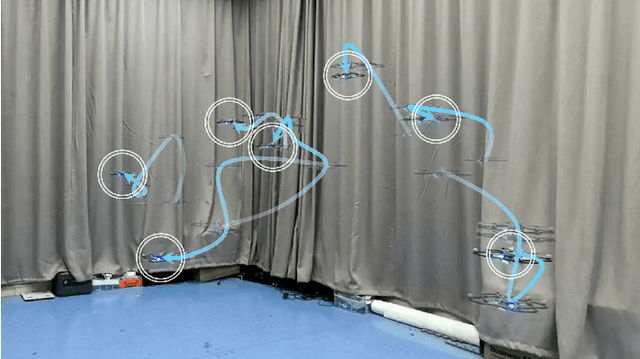
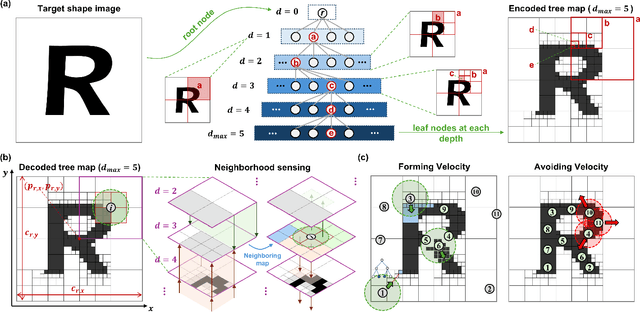
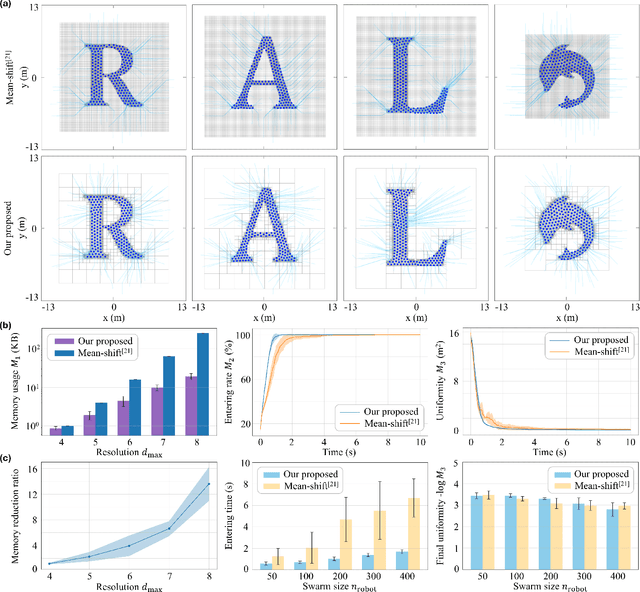
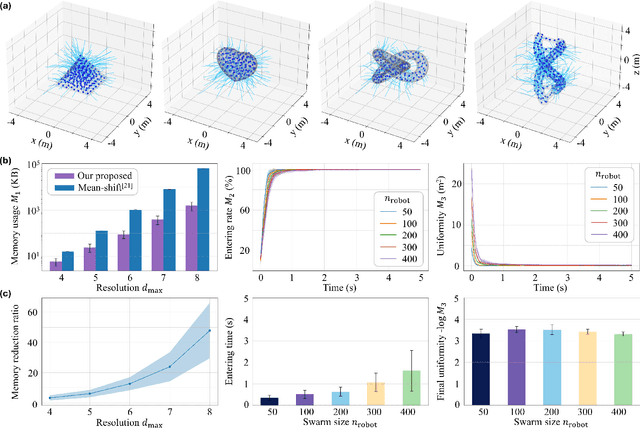
Abstract:Mean-shift-based approaches have recently emerged as the most effective methods for robot swarm shape assembly tasks. These methods rely on image-based representations of target shapes to compute local density gradients and perform mean-shift exploration, which constitute their core mechanism. However, such image representations incur substantial memory overhead, which can become prohibitive for high-resolution or 3D shapes. To overcome this limitation, we propose a memory-efficient tree map representation that hierarchically encodes user-specified shapes and is applicable to both 2D and 3D scenarios. Building on this representation, we design a behavior-based distributed controller that enables assignment-free shape assembly. Comparative 2D and 3D simulations against a state-of-the-art mean-shift algorithm demonstrate one to two orders of magnitude lower memory usage and two to three times faster shape entry while maintaining comparable uniformity. Finally, we validate the framework through physical experiments with 6 to 7 UAVs, confirming its real-world practicality.
SmokeBench: A Real-World Dataset for Surveillance Image Desmoking in Early-Stage Fire Scenes
Sep 16, 2025Abstract:Early-stage fire scenes (0-15 minutes after ignition) represent a crucial temporal window for emergency interventions. During this stage, the smoke produced by combustion significantly reduces the visibility of surveillance systems, severely impairing situational awareness and hindering effective emergency response and rescue operations. Consequently, there is an urgent need to remove smoke from images to obtain clear scene information. However, the development of smoke removal algorithms remains limited due to the lack of large-scale, real-world datasets comprising paired smoke-free and smoke-degraded images. To address these limitations, we present a real-world surveillance image desmoking benchmark dataset named SmokeBench, which contains image pairs captured under diverse scenes setup and smoke concentration. The curated dataset provides precisely aligned degraded and clean images, enabling supervised learning and rigorous evaluation. We conduct comprehensive experiments by benchmarking a variety of desmoking methods on our dataset. Our dataset provides a valuable foundation for advancing robust and practical image desmoking in real-world fire scenes. This dataset has been released to the public and can be downloaded from https://github.com/ncfjd/SmokeBench.
Proposal Report for the 2nd SciCAP Competition 2024
Jul 02, 2024Abstract:In this paper, we propose a method for document summarization using auxiliary information. This approach effectively summarizes descriptions related to specific images, tables, and appendices within lengthy texts. Our experiments demonstrate that leveraging high-quality OCR data and initially extracted information from the original text enables efficient summarization of the content related to described objects. Based on these findings, we enhanced popular text generation model models by incorporating additional auxiliary branches to improve summarization performance. Our method achieved top scores of 4.33 and 4.66 in the long caption and short caption tracks, respectively, of the 2024 SciCAP competition, ranking highest in both categories.
Learning A Spiking Neural Network for Efficient Image Deraining
May 10, 2024



Abstract:Recently, spiking neural networks (SNNs) have demonstrated substantial potential in computer vision tasks. In this paper, we present an Efficient Spiking Deraining Network, called ESDNet. Our work is motivated by the observation that rain pixel values will lead to a more pronounced intensity of spike signals in SNNs. However, directly applying deep SNNs to image deraining task still remains a significant challenge. This is attributed to the information loss and training difficulties that arise from discrete binary activation and complex spatio-temporal dynamics. To this end, we develop a spiking residual block to convert the input into spike signals, then adaptively optimize the membrane potential by introducing attention weights to adjust spike responses in a data-driven manner, alleviating information loss caused by discrete binary activation. By this way, our ESDNet can effectively detect and analyze the characteristics of rain streaks by learning their fluctuations. This also enables better guidance for the deraining process and facilitates high-quality image reconstruction. Instead of relying on the ANN-SNN conversion strategy, we introduce a gradient proxy strategy to directly train the model for overcoming the challenge of training. Experimental results show that our approach gains comparable performance against ANN-based methods while reducing energy consumption by 54%. The code source is available at https://github.com/MingTian99/ESDNet.
Low-light Object Detection
May 06, 2024Abstract:In this competition we employed a model fusion approach to achieve object detection results close to those of real images. Our method is based on the CO-DETR model, which was trained on two sets of data: one containing images under dark conditions and another containing images enhanced with low-light conditions. We used various enhancement techniques on the test data to generate multiple sets of prediction results. Finally, we applied a clustering aggregation method guided by IoU thresholds to select the optimal results.
Unpaired Deep Image Dehazing Using Contrastive Disentanglement Learning
Mar 15, 2022
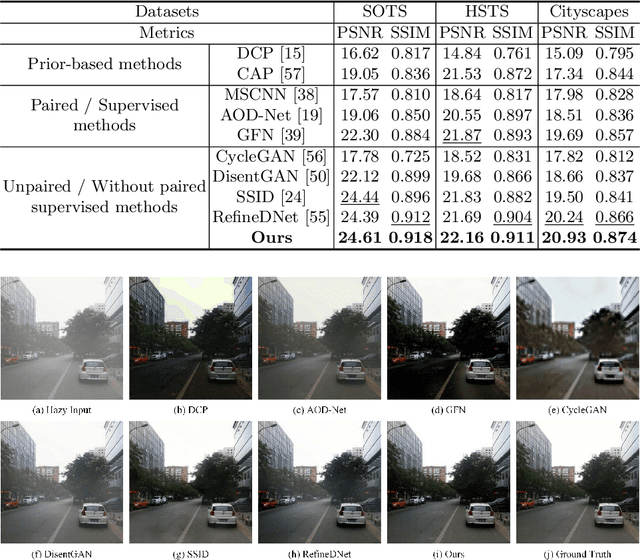
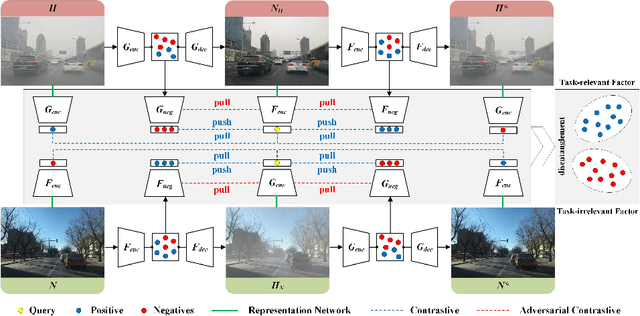
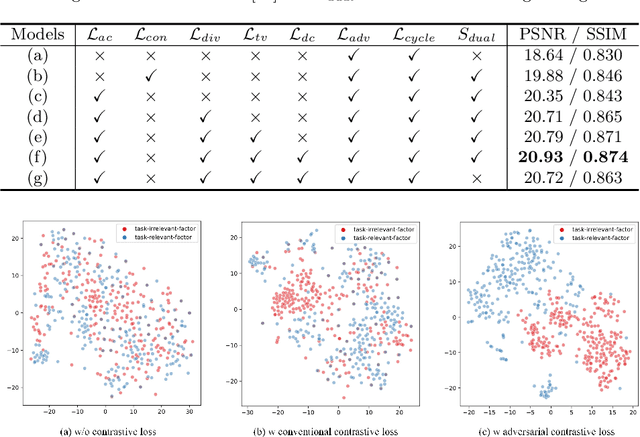
Abstract:We present an effective unpaired learning based image dehazing network from an unpaired set of clear and hazy images. This paper provides a new perspective to treat image dehazing as a two-class separated factor disentanglement task, i.e, the task-relevant factor of clear image reconstruction and the task-irrelevant factor of haze-relevant distribution. To achieve the disentanglement of these two-class factors in deep feature space, contrastive learning is introduced into a CycleGAN framework to learn disentangled representations by guiding the generated images to be associated with latent factors. With such formulation, the proposed contrastive disentangled dehazing method (CDD-GAN) first develops negative generators to cooperate with the encoder network to update alternately, so as to produce a queue of challenging negative adversaries. Then these negative adversaries are trained end-to-end together with the backbone representation network to enhance the discriminative information and promote factor disentanglement performance by maximizing the adversarial contrastive loss. During the training, we further show that hard negative examples can suppress the task-irrelevant factors and unpaired clear exemples can enhance the task-relevant factors, in order to better facilitate haze removal and help image restoration. Extensive experiments on both synthetic and real-world datasets demonstrate that our method performs favorably against existing state-of-the-art unpaired dehazing approaches.
 Add to Chrome
Add to Chrome Add to Firefox
Add to Firefox Add to Edge
Add to Edge